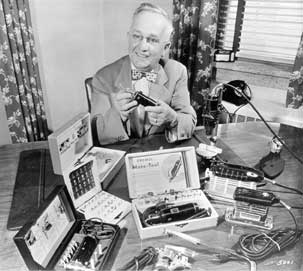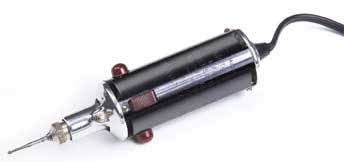
Back in the mid 1930s, Albert J. Dremel and his newly formed Dremel Company were in desperate need of a new product. He had started the company in 1932 to manufacture electric razor blade sharpeners — a design he invented. The devices were a money-saving hit with consumers. But, it didn’t take long for the competition to wise up: razor blade manufacturers slashed their prices in half and swiftly took Dremel’s customer base with them. The disposable razor blade was born. And, as Dremel’s corporate history explains it, the loss brought Albert and the young company “to its knees.”
But, Albert was never one to give up easily. He went back tothe drawing board and forged ahead with a brand-new invention and a different target market. This time around, it would be a high-speed, handheld miniature die grinder for the tool and die industry. Dremel’s new invention debuted in1934 as the Moto-Tool and met with good success. Outfitted with tiny aluminum-oxide grinding wheels, the tool was just the ticket for grinding the insides of molds. Dremel Company was back in business.
For the next decade or so, the Moto-Tool continued to be primarily an industrial tool. Then Dremel saw a new niche emerging for its successful little rotary machine. Urban America was beginning to embrace the concept of leisure time, and suddenly new hobbies were all the rage. What those model kits and miniature railroads needed was a small, easy-to-operate cutting and grinding tool to help them along. Dremel met that need with the Moto-Tool and ushered in the almost ubiquitous rotary tool we know today.
Since those early days in the hobby industry, Dremel has continued to develop and refine the rotary tool. In the mid 1960s, the company engineered a more stable motor design. Through many subsequent iterations, rotary tool bodies have become more ergonomic, variable speed was added, and other features such as locking arbors have made bits and accessories easier to change. In 1988, Dremel developed the first cordless Moto-Tool, which featured a NiCad battery. And, in the late 90s, Dremel was the first American tool company to develop a Lithium-ion battery. Their cordless rotary tools were also seeing substantial boosts in motor speeds—up to 20,000 and then 35,000rpm—speeds comparable to corded routers.
These days, there are more than 17 million corded and cordless Dremel rotary tools in use, and, according to brand manager John Hauter, the company has seen steady growth over time. That’s due in part to the broad range of uses we find for these tools. “Woodworkers use them for power carving, and luthiers love the plunge router base attachment for installing inlay and marquetry in fret boards. Architects use our rotary tools to build foam-core models. DIY warriors, craftspeople, jewelry makers and other fine artisans use our tools. Lately computer gamers are using Dremel rotary tools to customize their computers in many ways,” Hauter says. “We’re even selling our tools to the ‘import tuner’ crowd for porting intake and exhaust manifolds on their cars.”
“Dremel rotary tools are a good fit wherever the end usercan benefit from high speed but low torque. That combination of factors enables a rotary tool to offer a high degree of control and precision unmatched by other handheld power tools.”
Hauter says cutting tools, and specifically cutoff wheels and high-speed steel carvers, are some of the more popular accessories, among more than 150 available options. The EZ Lock™ mandrels, added to the product line a few years ago, make various cutters, sanders and polishing wheels simple to replace. There are numerous attachment options too, including a Flex Shaft for power-carving, a grout remover, a drill-press style Workstation™, a chainsaw sharpener, a jigsaw-type Multisaw and now a miniature planer. The list of accessories continues to grow.
Consequently, while it seems disposable razor blades are here to stay, thanks to that early setback in Dremel’s history, so too are the company’s versatile, ever-popular rotary tools.









